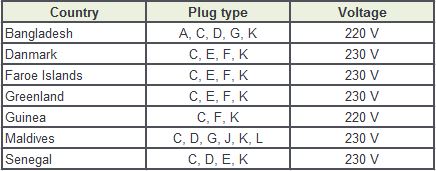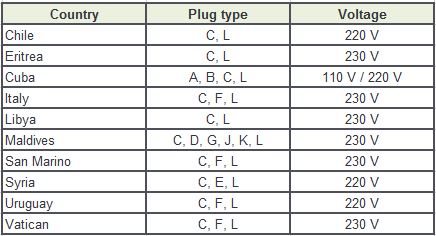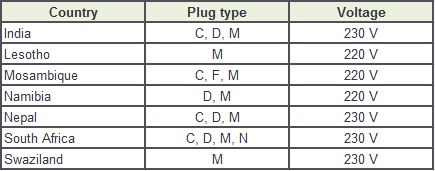Plug Types
You want to buy a lamp or an electrical device, but do not know if the plug and your sockets are compatible? And if you, if necessary, should order an adapter? Then this is the place for you. On this page, learn all the plug types of the lamps and electrical appliances offered in the shop.
And here's how: Please clarify what type of plug the article of your choice has. You can look it up on the product’s page under “Properties”. You’ll find all information on this plug type respective plug category in the following: a picture, a description, and the country in which the type of plug is common.
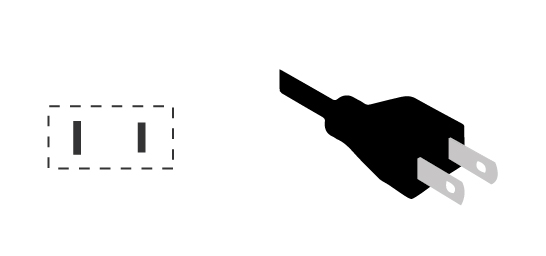
The plug type A (or NEMA-1) has two flat live contact pins, which are arranged in parallel at a distance of 12.7 mm. The contacts are between 15,875 18,256 mm long, 6.35 mm wide and 1,524 mm thick. The plug-type A is especially used for smaller devices. Due to its design, the plug is not protected against polarity reversal.
Find out in which countries this type of plug is common, what alternatives there are and with how many volts it is operated in the following country list (in alphabetical order):
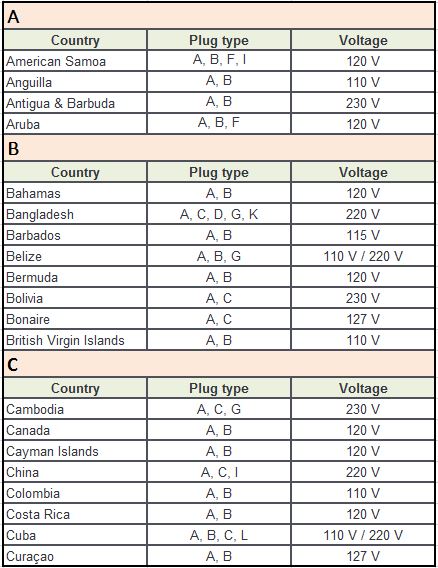
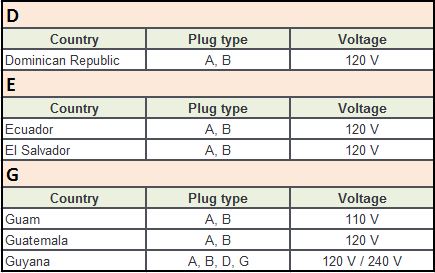
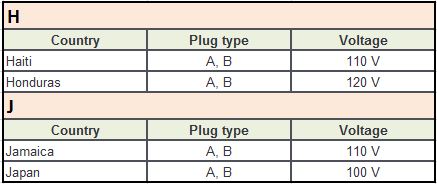
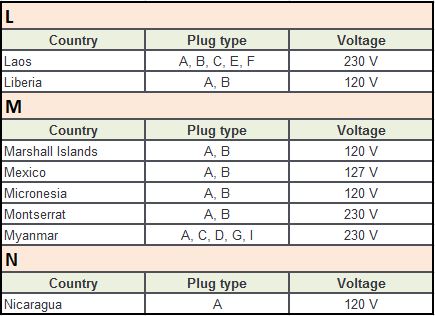
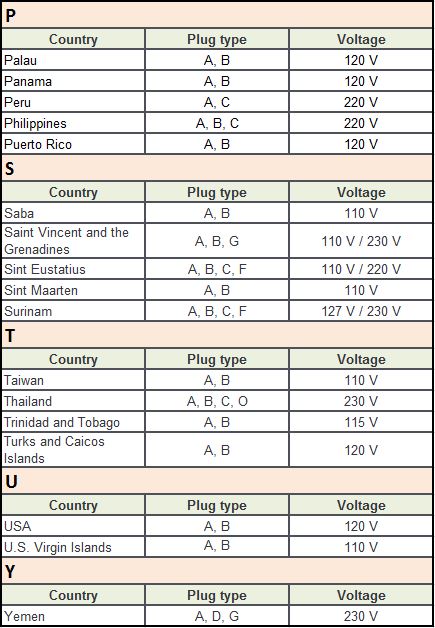
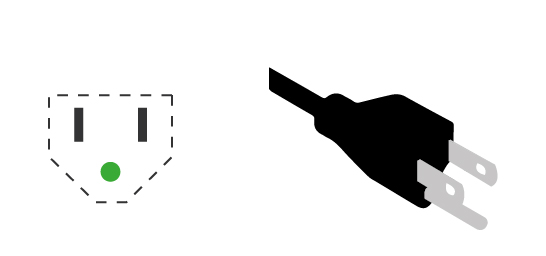
The plug type B (or NEMA 5-15, 3 pin) has two flat live contact pins, which are arranged in parallel. The size and the distance are identical to plug-type A. An additional offset arranged, circular contact serves as a protective conductor. This design makes the plug protected against polarity reversal. The protective conductor contact is longer than the two other pins and therefore joins the socket before them.
Find out in which countries this type of plug is common, what alternatives there are and with how many volts it is operated in the following country list (in alphabetical order):
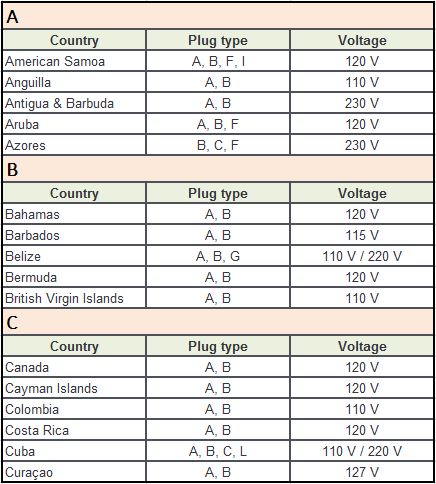
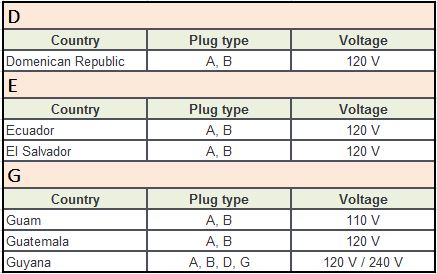
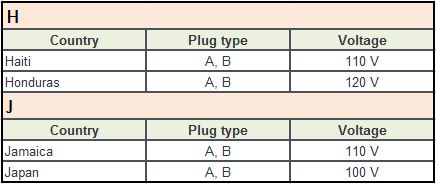
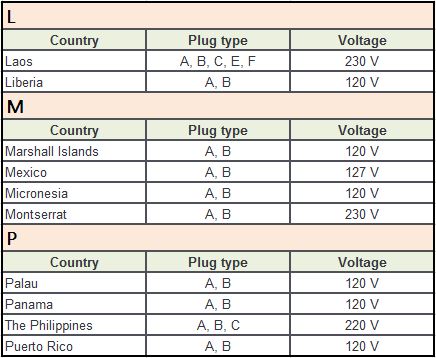
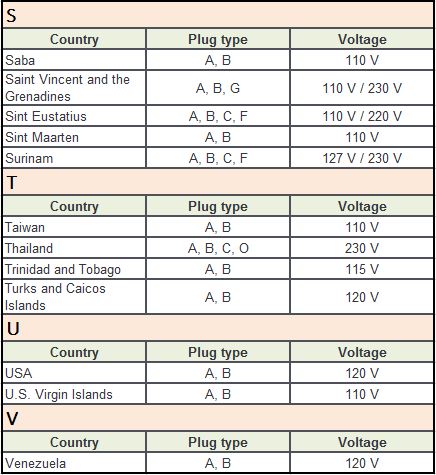
There are two different connectors of type C:
- Plug Type C: CEE 7/17 or contour plug and
- Plug Type C: CEE 7/16 or Euro plug.
Please select the appropriate tab for relevant information.
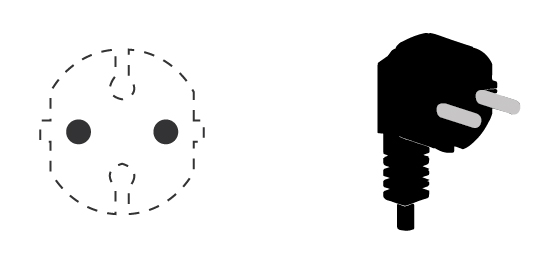
The contour plug (or plug CEE 7/17) has two contacts with a length of 19 mm and a diameter of 4.8 mm, which have a distance of 19 mm. The plug has about 10 mm above as well as at the same distance below the axle a cut-out. One has a shaft with round tip directed to the plug’s center, which allows the French earth pin to be taken in. And these two cut-outs both are rectangular towards the plug’s edge to allow the German earth clips to connect.
The maximum power for devices of this type is about 3500W. The contour plug may be loaded with a maximum of 250V. The cut-outs cause that the plug is not protected against polarity reversal, since they provide only space for the French ground pins, but it isn’t properly connected.
The contour plug fits in German, French and Danish sockets, in comparison with the Europlug it is incompatible with Swiss sockets.
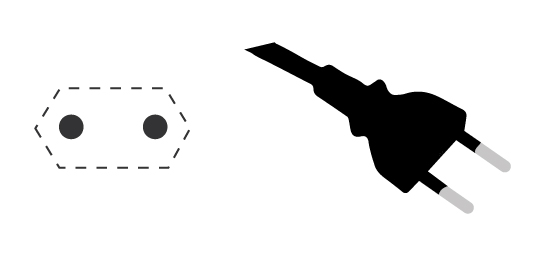
The europlug (or plug type CEE 7/16) can be used in most parts of Europe with the exception of the United Kingdom, Ireland, Cyprus and Malta. It has no protective conductor, which is why it is not protected against polarity reversal. Its contacts have a diameter of 4 mm and are placed at a distance of 19 mm.
Find out in which countries this type of plug is common, what alternatives there are and with how many volts it is operated in the following country list (in alphabetical order):
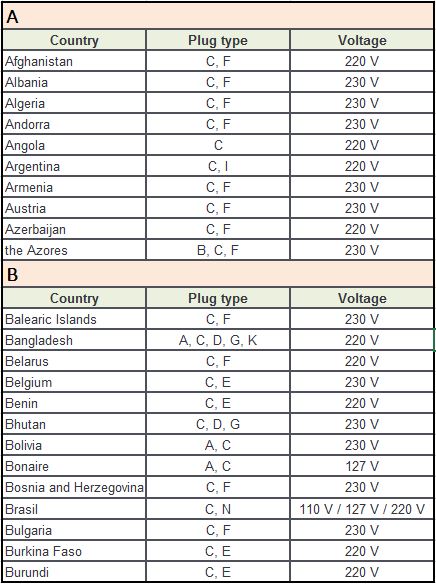
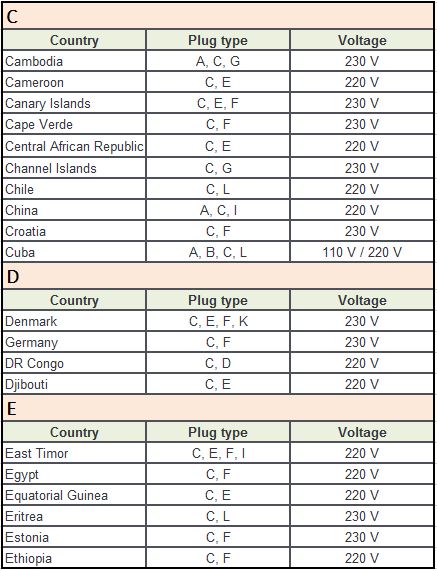
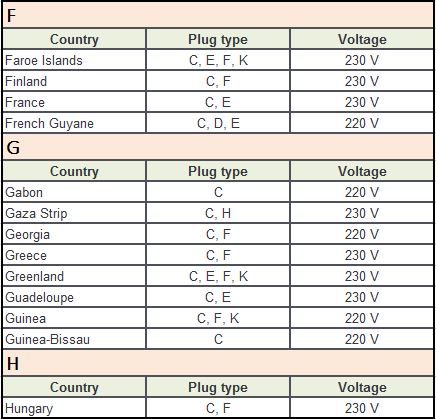
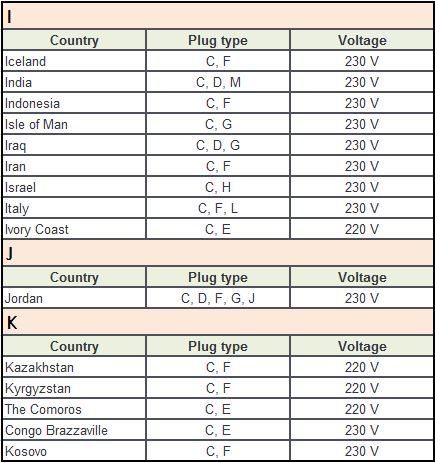
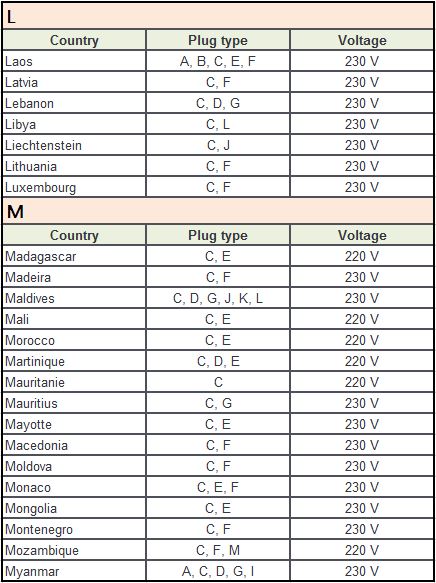
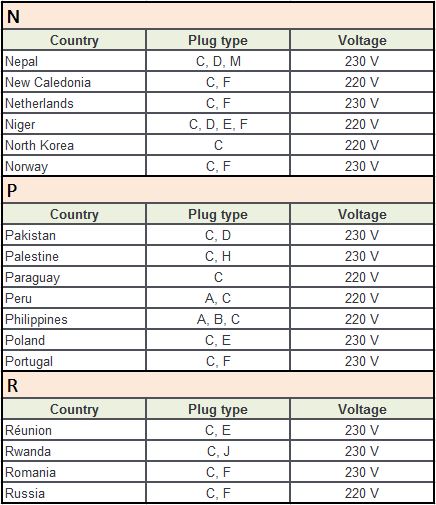
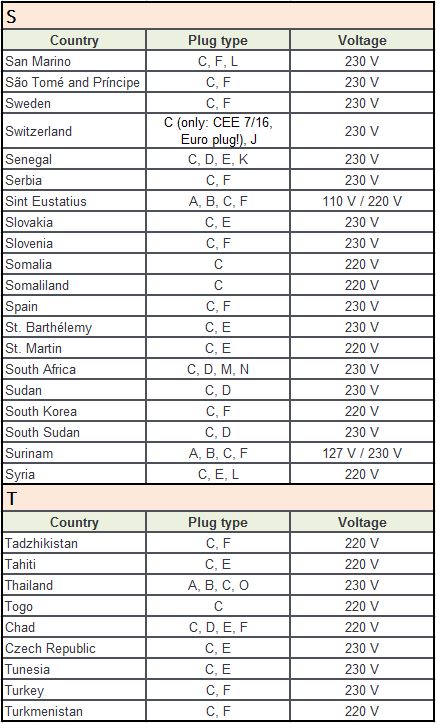
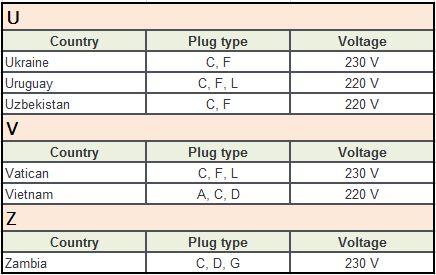
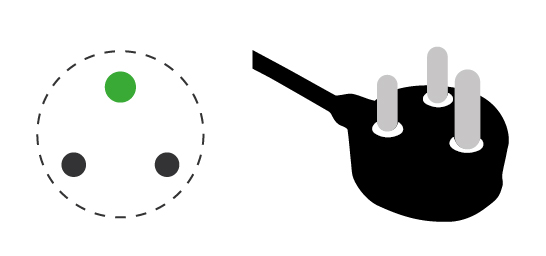
Plug type D (or type (5A) / (BS 546) was formerly widely used in the United Kingdom and finds use today especially in India and South Africa. In Libya, it is even the only type of plug, but in most other countries it was replaced by plug type G. The earthing contact is slightly longer (20.6 mm) and thicker (7,06 mm), as the two current-carrying contacts (length, 14.8 mm / diameter 5.08 mm), which is why it enters the power supply first. The plug’s construction inevitably protects it against polarity reversal, but due to the consistently conductive contacts it is not safe to touch.
In the following country list (in alphabetical order) you can find out in which countries this type of plug is common, what alternatives there are and with how many volts it is operated:
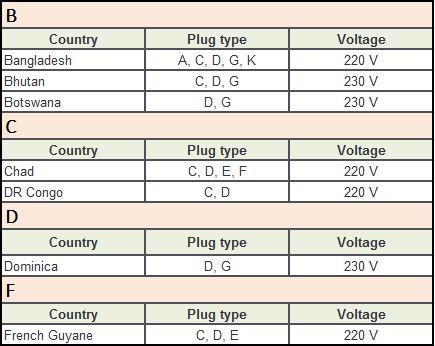
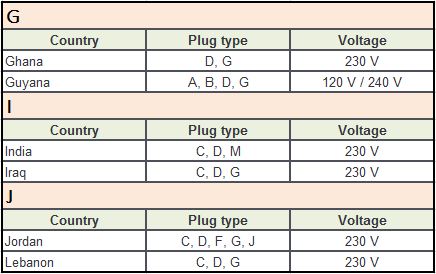
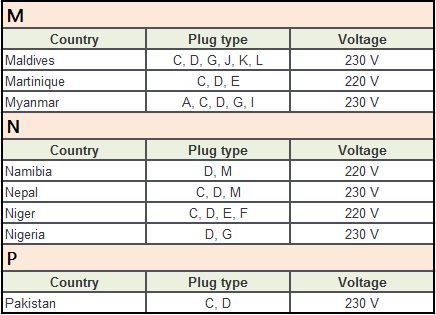
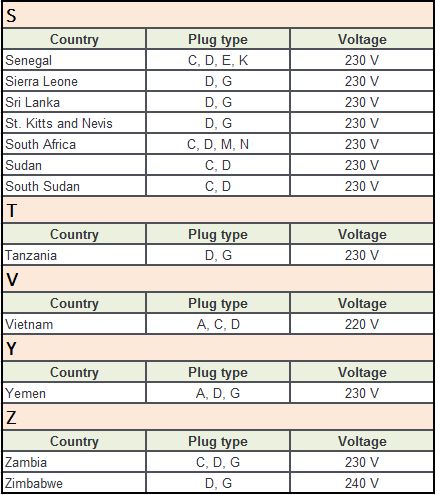
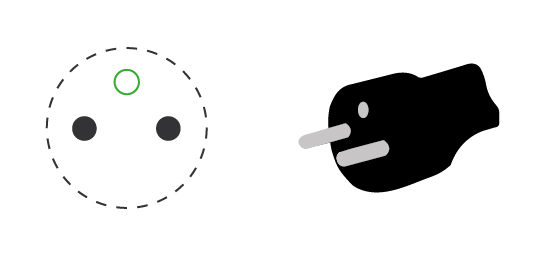
The French plug type E or type CEE 7/5 has two round, live pins. These are usually thicker than the contact pins of the europlug, but you can also come across variants with thin pins (4 mm). Slightly moved upwards but in the middle the two pins is an aperture that takes in the contact pin of the French socket’s protective conductor. When plugging a device into the socket, it first connects with the protective conductor and only afterwards with the two live pins, and the other way around when removing the plug. Because of its design, the system does not allow polarity reversal, for there is only one way to connect the plug with the socket.
In the following country list (in alphabetical order) you can find out in which countries this type of plug is common, what alternatives there are and with how many volts it is operated:
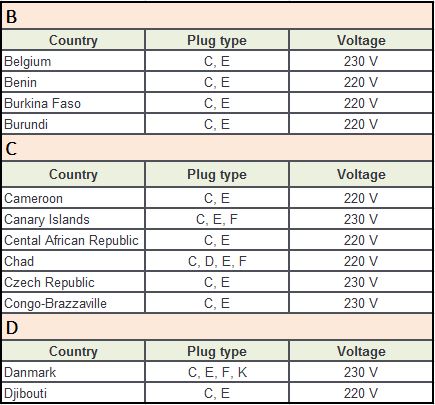
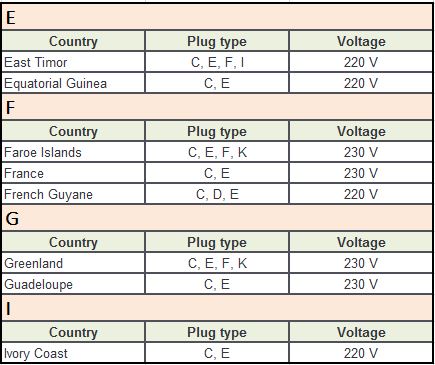
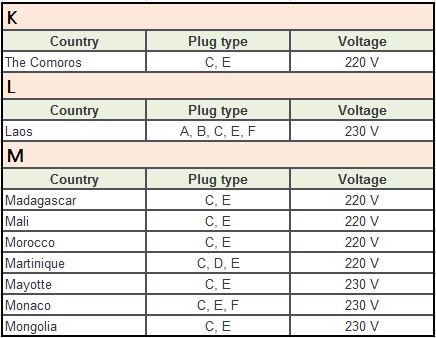
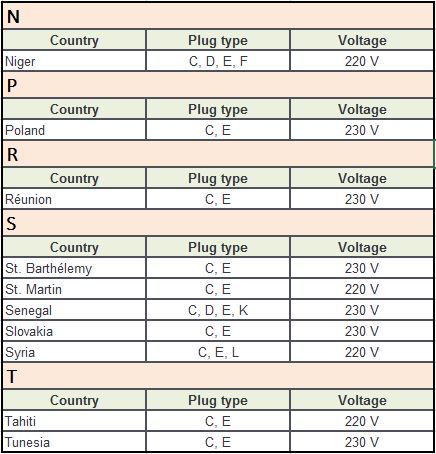
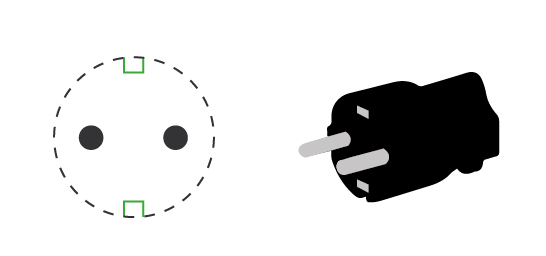
The Schuko plug or CEE7/4-plughas two round pins with a diameter of 4.8 mm and 19 mm length. Schuko is an abbreviation for the German word Schutzkontakt, which means "Protective contact" - in this case "protective" refers to the earth. Both contact pins are 19 mm apart. A third pole, the protective contact, is supposed to conduct fault currents, which can occur, for example, in the event of a short circuit as soon as the two other poles close the electric circuit. Therefore, the connection to the earthing contact must take place first. For the Schuko plug, this is guaranteed through contact surfaces on the plug’s side and the socket’s corresponding contact springs. The covering’s basic level is surrounded by an approximately 19 mm high collar for the protection against accidental contact. Thus the contact pins can only be touched as long as they are outside the socket.
In the following country list (in alphabetical order) you can find out in which countries this type of plug is common, what alternatives there are and with how many volts it is operated:
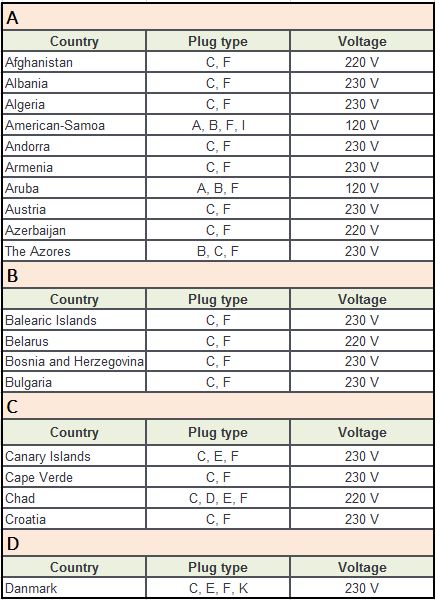
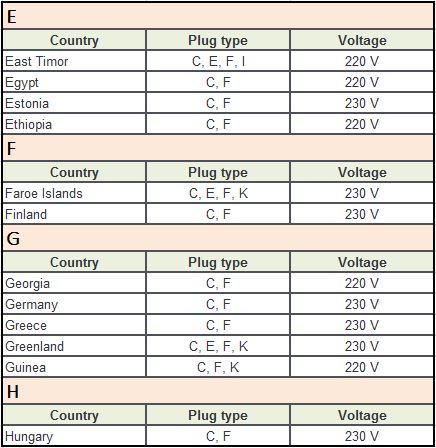

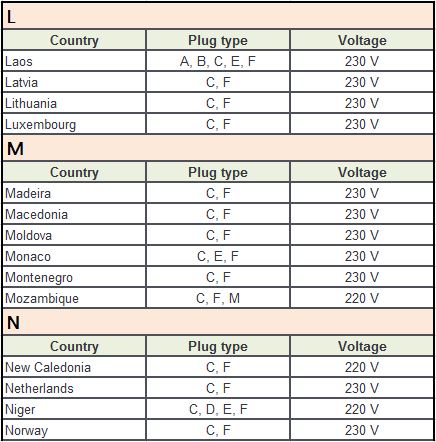
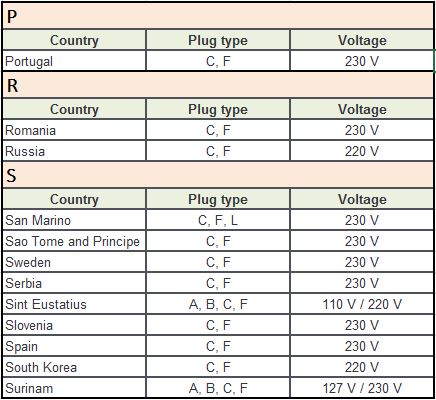

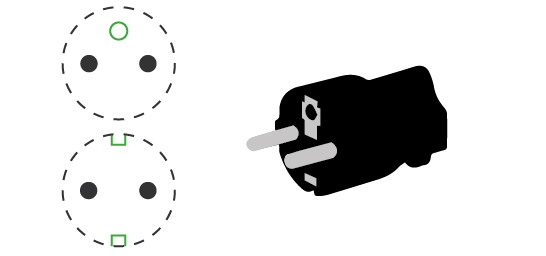
The plug type E + F or hybrid plug (or: CEE 7/7) represents a mixture of type F and E and fits in all the countries where you can use the E or F-type plug. In the country list of the plug types E and F you can find out in which countries this type of plug is common, what alternatives there are and with how many volts it is operated.
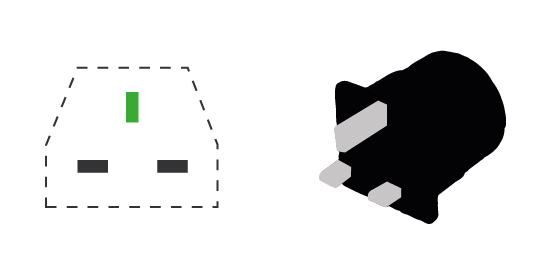
Plug type G or even BS 1363, Commonwealth plugalways has three pins and is equipped always with a fuse. The two contacts measure 4 x 6 x 18 mm, of which 9 mm are insulated and are 22 mm apart from each other. The earthing pin is located centrally over the two other contacts, also with a distance of 22 mm. It has the size 4 x 8 x 23 mm. The protective contact has no additional insulation - but the two live contacts do. The plug’s housing is wide to impede an easy touching of the contact pins.
In the following country list (in alphabetical order) you can find out in which countries this type of plug is common, what alternatives there are and with how many volts it is operated:
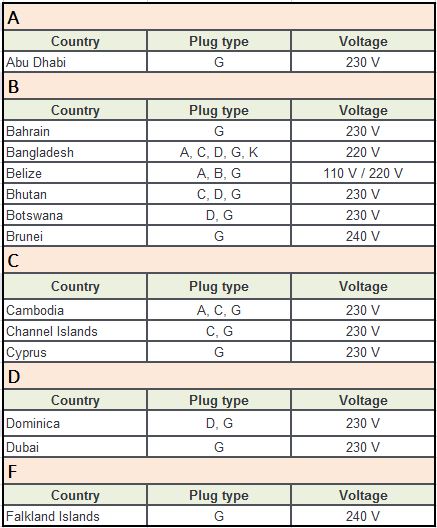
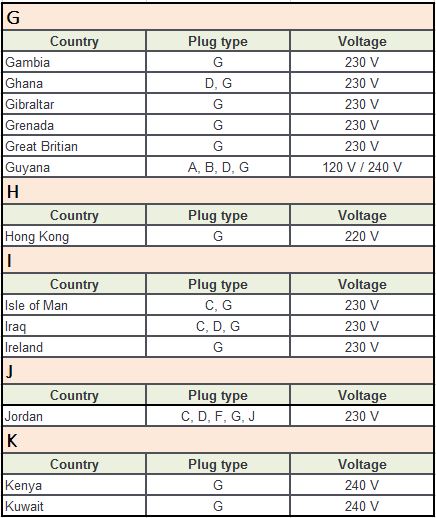
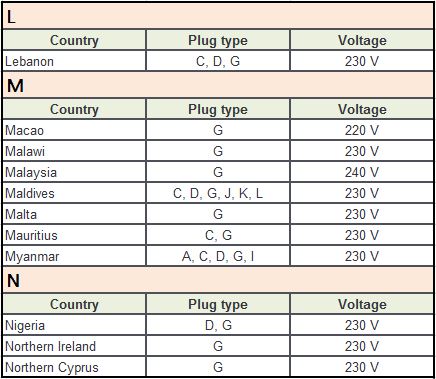
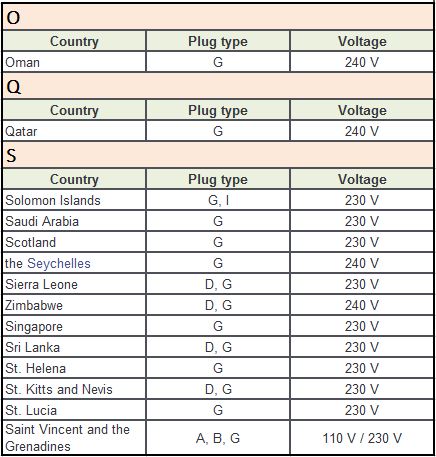
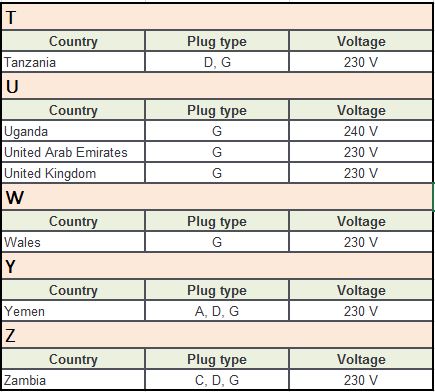
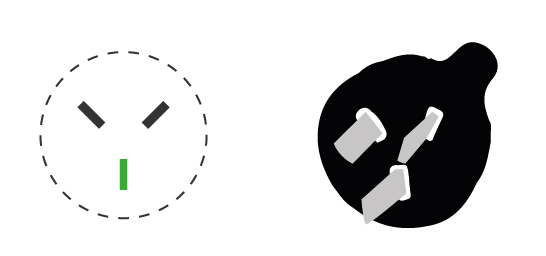
The plug type H (or: SI-32) can be found only in Israel and the Palestinian territories and fits into no other plug system. It has three flat or round pins in Y-shape. The third pin is also an earthening pin. Most outlets, which occur in these regions are by now adapted to also take in the europlug of type C. Since the redesign in 1989 plug H’s pins are no longer flat but round. Each contact pin has a diameter of 4 mm. The modern sockets in Israel and the region also allow the Schuko plug (type F), but please not that the protective contact is not guaranteed!
In the following country list (in alphabetical order) you can find out in which countries this type of plug is common, what alternatives there are and with how many volts it is operated:
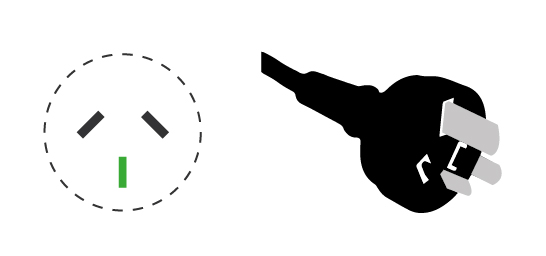
Plug type I or AS 3112consists of a total of three contact pins - one protective contact pin and two live pins. The earth contact is a vertical flat pin, the other two pins are positioned in the form of an inverted V above. They are each rotated by 30° against the protective contact and are 13.7 mm apart. Since 2005, the two live contacts need to be insulated and therefore safe to touch.
In the following country list (in alphabetical order) you can find out in which countries this type of plug is common, what alternatives there are and with how many volts it is operated:
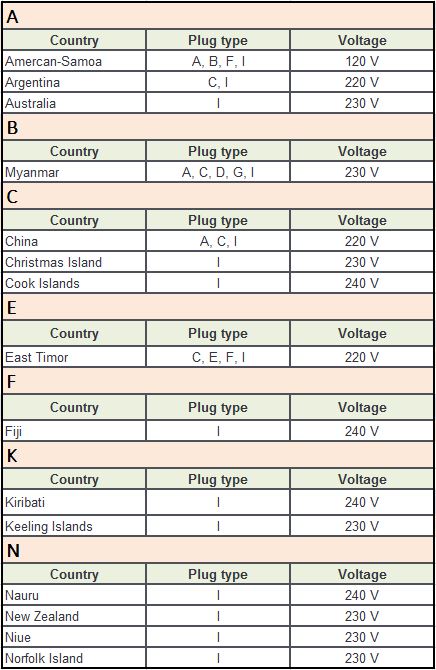
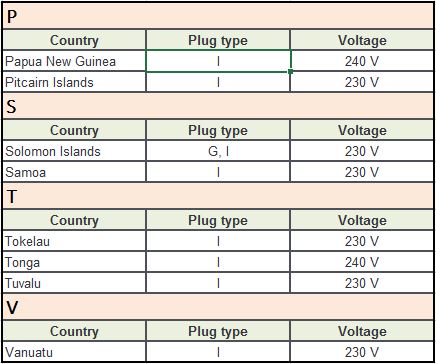
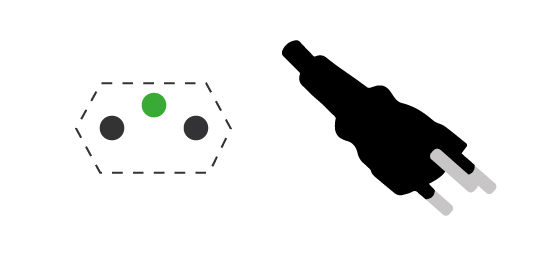
Plug type J or SEV 1011 has three pins. The medium-sized, slightly offset one, is the protective contact. Although all pins have the same length, the protective contact is leading ahead, as both holes for the live contacts are much deeper into the socket. The offset arrangement guarantees the plug to be protected against polarity reversal.
In the following country list (in alphabetical order) you can find out in which countries this type of plug is common, what alternatives there are and with how many volts it is operated:
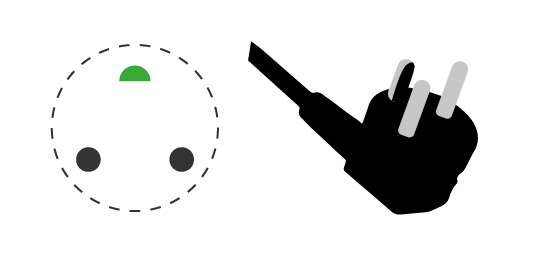
Plug type K or DS 60884-2-D1 consists of two live pins and one protective contact pin. Through the protective contact, the design is asymmetrical, making the plug protected against polarity reversal. Although the protective contact’s pin is shorter, it is still leading, because it is the first to reach the socket. The plug type C (Europlug) and type F (Schuko plug)fit mechanically into the socket of the type K , but in this case the protective contact is not connected.
In the following country list (in alphabetical order) you can find out in which countries this type of plug is common, what alternatives there are and with how many volts it is operated:
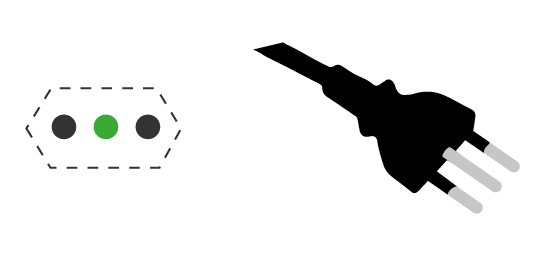
There are two versions of the plug type L (or CEI 23-16-VII). Both versions have two round pins whose shafts are insulated. In the middle is a further, equally long, but non-insulated pin for the protective conductor. A protective collar around the outlet is not provided.
10 A Plug
For the version 1, the two outer pins are 19 mm apart from each other, the earth pin is located in the middle. The pins are 4.5 mm thick. The outer pins have a contact protection. The Europlug (type C) fits into the outlet of this type.
16 A Plug
Version 2 is characterized by contact pins of 5.1 mm, but the distance of the outer pins is 26 mm. This means that the two versions are incompatible with one another. The earth pin again is between the live pins.
In the following country list (in alphabetical order) you can find out in which countries this type of plug is common, what alternatives there are and with how many volts it is operated:
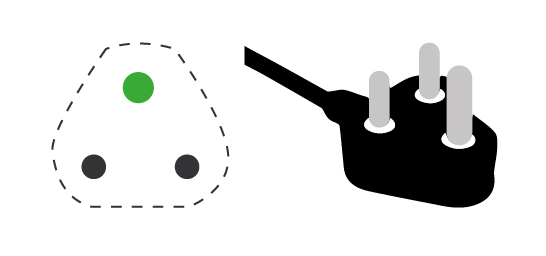
The plug type M or 15-A version of the type D or also BS 546 consists of three pins: two live and one protective contact pin. The contacts’ arrangement protects the plug against polarity reversal.
The contact pins for the two electrical contacts are 25.4 mm apart, have a diameter of 7.06 mm and a length of 18,94 mm. The pin for the protective earth conductor has an 8.71 mm diameter and a length of 28,89 mm.
In the following country list (in alphabetical order) you can find out in which countries this type of plug is common, what alternatives there are and with how many volts it is operated:
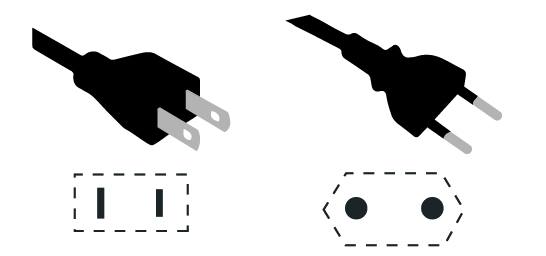
Some manufacturers supply their products always with two different plugs, a plug type A (left), and a plug type C (right). For more information on the individual plugs please open the respective tab.


